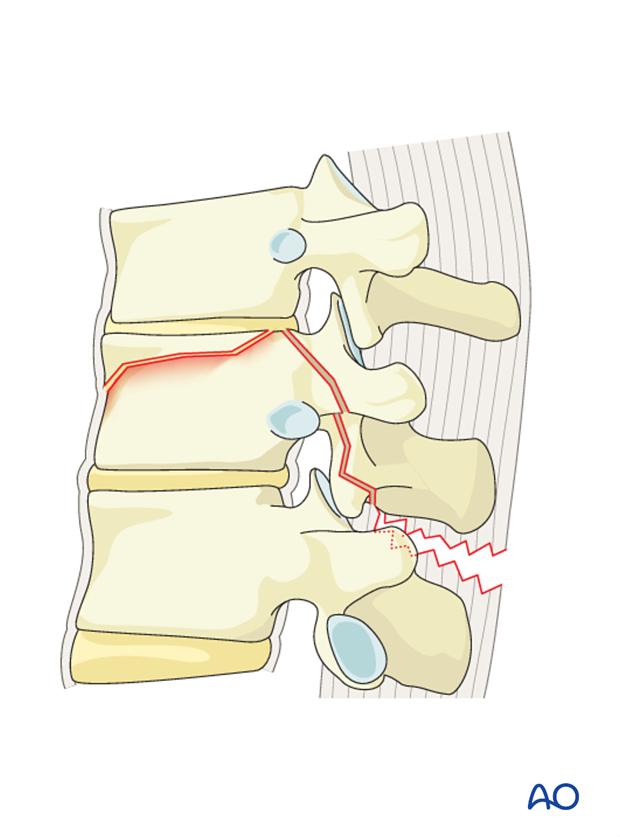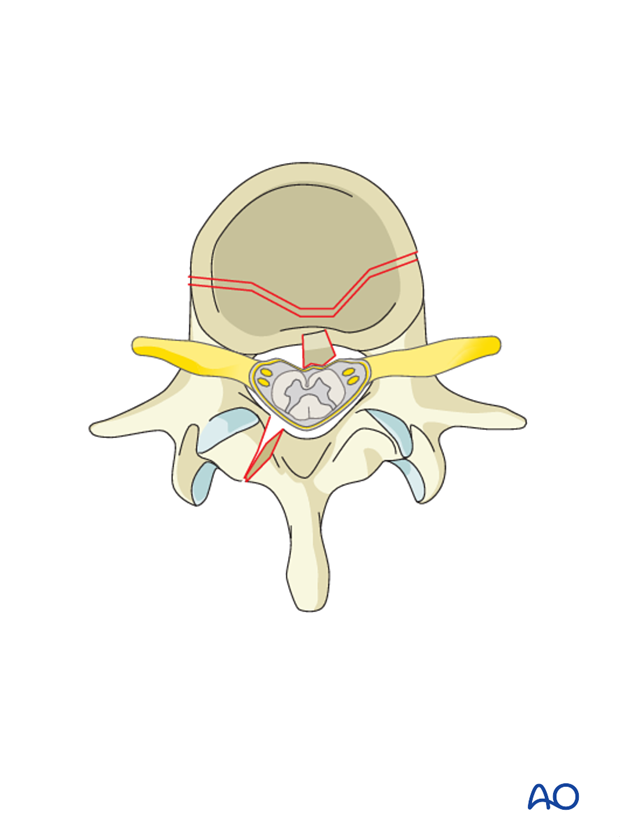Posterior short segment fixation with Schanz pins
1. Introduction
Preliminary remarks
B2 injuries indicate a bony and/or ligamentary failure of the posterior tension band together with a Type A fracture of the vertebral body. Type A fracture should be classified separately as management depends on both.

Decompression
In cases where neurological deficit is observed and compression of the spinal canal is assumed, decompression has to be performed. It should be understood that this is a step that can also result in deterioration of neurology unless very meticulously performed.
Decompression can be performed anteriorly or posteriorly. Posteriorly decompression can be indirect or direct.
Indirect decompression may be tried before performing direct decompression.
Please refer to Decompression techniques for a detailed discussion of indications for the posterior decompression techniques. (Posterior decompression)
Repair of dural laceration
More details on repair of dural laceration can be found here.
2. Patient preparation and approach
The posterior open approach to the midline is used together with the appropriate patient preparation.

3. Closed reduction
Primary reduction is performed by positioning of the patient onto a frame to create lordosis.

4. Reduction with Schanz pins
Preliminary remarks
Due to the fact that bilateral instrumentation is necessary in all cases, all steps described below are repeated on the opposite side, unless described otherwise.

Pitfall: Multisegmental fixation
In the thoracic spine, multisegmental stabilization is necessary in general.
If this is the case, pedicle screws have to be used instead of Schanz pins.
Schanz pin insertion
In patients with significant kyphosis, PSSF-SS can be used to achieve better fracture reduction and lordosis. However, additional anterior reconstruction may be needed to prevent implant failure.
Schanz pins are inserted into the vertebrae cephalad and caudal to the fracture level on both sides, using the starting point and trajectory as described in pedicle screws. ( Schanz pin insertion)

The fracture clamps are placed on the proximal and distal Schanz pins.

Rod insertion
The rod is inserted through both the clamps and the whole construct is pushed towards the spine.

The distance between the two Schanz pins is secured by tightening the rod to the fracture clamps.

Decompression
If it is decided to perform an indirect decompression, this is done at this stage. If indirect decompression proves to be insufficient, a direct decompreesion eg, posterior or transpedicular decompressions are undertaken. Refer to the Posterior Decompression techniques for detailed instructions. ( Posterior decompression)

Lordosis
The kyphosis is corrected using the Schanz pins restoring the normal lordosis.
Whenever there is a fracture of the posterior wall (A3/A4/B2), the lordotic correction needs to be supported by C-washers (placed 0.5 cm from the nuts). This will avoid retropulsion of the fractured fragment.
This transfers the center of rotation from the posterior wall to the rod.

Normal lordosis is restored.

The angle of the Schanz pins is fixed by tightening the Schanz pins to the fracture clamps.

Distraction
The rod fixation is released from the fracture clamp and distraction of the Schanz pins is performed using a distraction device or the C-washer. This restores the height of the vertebral body, especially in the posterior part.

Pitfall: Avoid overdistraction
Care should be taken to avoid overdistraction in type B2 fractures.
The distance between the two Schanz pins is secured by tightening the rod to the fracture clamps.

When reduction is achieved, the Schanz pins are cut.

The final construct is shown from a lateral view.

5. Fusion
Decision
Although fusion was routinely performed for all spinal fractures, its indications are now being restricted to fractures that are highly unstable.
Nonfusion fixations can be performed for A3, A4, and B1 type injuries.
Fusion is routinely performed for A2, B2, B3, and all C injuries as they are unstable injuries with extensive soft tissue and ligamentous disruption.
If the surgeon plans for a fusion, the facet capsule is excised and the joint cartilage surfaces are denuded/ curetted.

Pieces of bone graft (autograft, allograft) are inserted into the decorticated facet joint for fusion.

6. Intraoperative imaging
Prior to wound closure, intraoperative imaging is performed to check the adequacy of reduction, position, and length of pins and the overall coronal and sagittal spinal alignment.

7. Aftercare for posterior procedures
Patients are made to sit up in the bed on the first day after surgery. Bracing is optional. Patients with intact neurological status are made to stand and walk on the second day after surgery. Patients can be discharged when medically stable or sent to a rehabilitation center if further care is necessary. This depends on the comfort levels and presence of other associated injuries.

Patients are generally followed with periodical x-rays at 6 weeks, 3 months, 6 months, and 1 year. Normally, 5-10 degrees of loss of kyphosis can be observed within the first 6 months, which does not affect the functional outcomes. For nonfusion surgeries, the implants can be removed once fusion is confirmed.














